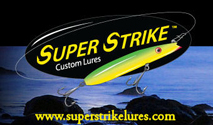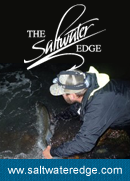After another successful Striperthon it seems like the right time to talk about the evolution of the striper tournament. The phrase “no kill” is often used to emphasize the fact that most (if not all) of the fish entered into one of these tournaments will be released. It’s a concept I really believe in, some of you may know that I run GoTight.Net which is the online home of a very successful season-long catch and release surfcasting tournament.
There has been plenty of debate about the likelihood of survival for fish that are brought to shore for photographic documentation and, when done carelessly, I would agree that survival rates are below what any of us would prefer. But, when done correctly the fish are really not kept out of the water any longer than they are during a normal shore landing.
The right way to compete in one of these tournaments is to prepare to measure your fish before making your first cast. I compete in my own tournament but, of course, I can’t win anything I just enjoy the camaraderie that comes with playing the game every week. When I arrive at my spot of choice, I start by finding a good place to document my catch. The best places are flat areas of smooth gravel, flat boulders or, best of all, patches of wet weeds uncovered by the tide. When I find a suitable spot, I unfold and lay out my measuring device (in my case it’s a fiberglass folding ruler) and then make sure I have my tag and camera in an easily accessible spot before I make my first cast (I also make sure the flash is turned on). One of the big no-no’s of competing in these C&R events is recording your fish on dry sand, if your fish looks like a cinnamon doughnut when you go to release it, no matter how fast you are, it’s not going to do well. Sand in their slime, gills and eyes can cause infection and can be very hard for them to rid themselves of, if you fish the open beach you should document on hard, wet sand or bring a small tarp or towel to take your photos on.
From the moment you hook up, you should be thinking about the documentation process and hear a clock ticking in your head. Try to get the fish in as quickly as possible, I prefer to unhook the fish right when I catch it and then bring it over to the ruler. Lay the fish down near the ruler, move the ruler (not the fish) to line up with the tip of the tail and take the photo, pick the fish up for a quick selfie and the documentation process is done. Now I usually set a rock on the tag so it doesn’t blow away, I stuff my camera in my jacket or the neck of my wetsuit and then I hurry the fish back to the water where I will take whatever time is necessary (as I always do) to revive it. Written out, this sounds like it takes a long time, but I can usually document a fish and have it back in the water for revival in less than 30 seconds.
When you catch a big fish, there is a little more to the process. Bigger fish are usually on the line longer and have fought pretty hard. If I had to run a 30 yard dash and then go hold my breath underwater for 30 to 60 seconds I don’t think I’d be feeling too great by the end of my swim. The accepted process is to land the fish, remove the hook and then spend a minute or two reviving the fish on a Boga Grip or other lip-gripper tool before taking it to shore. After that short time in the water, I bring the fish in and go about the documentation process as I would for any other fish. This same basic process is used for any fish caught wetsuiting that has to be swum back to shore, keep the fish on the gripper and in the water until the last possible second before quickly documenting and releasing the fish.
Is this a perfect process? No. Is there a measure of release mortality? Yes. But, when done properly, I doubt very much that it’s any higher than regular fishing practices. One thing you can guarantee is that the mortality rate for every conventional “weigh-in” style striper tournament is 100%. If you compete with swift and proper release in mind, you should not have any problem safely releasing all of your fish. Just remember that being quick while the fish are out of the water and taking ample time for revival and release are the two major keys to release success—whether you’re in competition or not.













So like myself. i’m guessing that you didn’t like the manner that the top ranked fish was measured this past weekend? Who doesnt like to be a chicken cutlet right out of the water.
↓Hi Danderson,
My family was recently stationed overseas in Italy and I am wondering if even though I am out of the country, am I eligible to compete in the Catch and Release competition on gotight.net ?
Thanks,
↓Alex
Wont say too much other than catch and release “should” be the only way to run any kind of comp in fishing, these days. So much damage to the fish stocks on both sides of the Atlantic has been done that to even consider a kill and display comp should simply be out of the question.
Excellent write up, Danderson, and very well put aout th importance of both preparation of your photo / measuring sire before actually fishing and the release of the fish / revival afterwards. Top marks mate!!
Ady
↓I totally agree, but some fish won’t make it anyway, with the use of treble hooks and fish management while de-hooking. Also, I believe the head and charter boats should ask clients if they really want the cows. I would say de-hook the cow, weigh it and send it on its way. My thoughts
↓Hey Dave, excellent article. Any tip on getting the pics to show the actual length of the fish? All my pics for cpr always show the fish to be 1-2.5″ less than the fish actually tapes out. The bigger the fish, the more the pics seems to short it. For instance the fish i won this sj with taped out at 50″ yet the pics only show it to 48″. I guess my question would be is it something I’m doing wrong with the pics or is it just part of the whole cpr thing and everyone’s fish looks shorter in pics than it actually is? Figured out of anyone you’d know best! Thanks!
↓Ryan, my fish also looks short in the picture, it was 47.5 and you can’t tell it’s anything over 45 (that, and my pictures were TERRIBLE, and I couldn’t get my tape to lie flat). Congrats again by the way.
↓Pingback: A 2015 Big Fish Season Primer | New England Surfcasting
Yeah, wish I had read this article before I went out. I won’t be unprepared again. My pictures were terrible, as I was 100% unprepared, even though I knew I could catch a big fish (wasn’t exactly random obviously). Next time, I’ll have a plan in action before it happens- reminds me of having to be prepared for a flat tire when I used to bike race. If you aren’t prepared, you’re screwed. If you are, you can recover. Also, now I’ll be prepared for all CPR, not just tournaments. I admit I’ve never done the recovery BEFORE taking pictures, and I like that, and will implement it. Thanks for this Dave.
↓Thanks Jerry, congrats to you too. I saw your fish up there Sat morning and knew it was gonna take a good one to beat it! I was lucky enough to get that bite at the right time. This is a great article. I’ve never revived a fish before the measure, but will be now. I prepared last year for the cpr tourneys by reading the go tight website and also purchased a folding ruling they recommended, which makes it alot easier. Typically it takes me longer to unhook a fish than it does to get the pics. Unfortunately my fish decided to flop around and cover herself with sand. Before I took the fish I cleaned off the sand and revived her – she was a lively one and I almost didn’t get the shot! Thanks Dave, Zeno, all the sponsors and congrats to all who put up fish for this!
↓I fish solo, and to take 1 pic with the tag and tape is ok, but to take a second one a selfie , I can’t under stand this, for me it takes too long to do, so I don’t , I guess I will never wine one, but it ok ,. Just had to share
↓If you place the measuring tape on top of the fish, it will measure a few more inches due to the thickness of the fish. If the fish were flat, the measurements with the tape on the ground would be the same.
↓How about a Fall contest?
↓